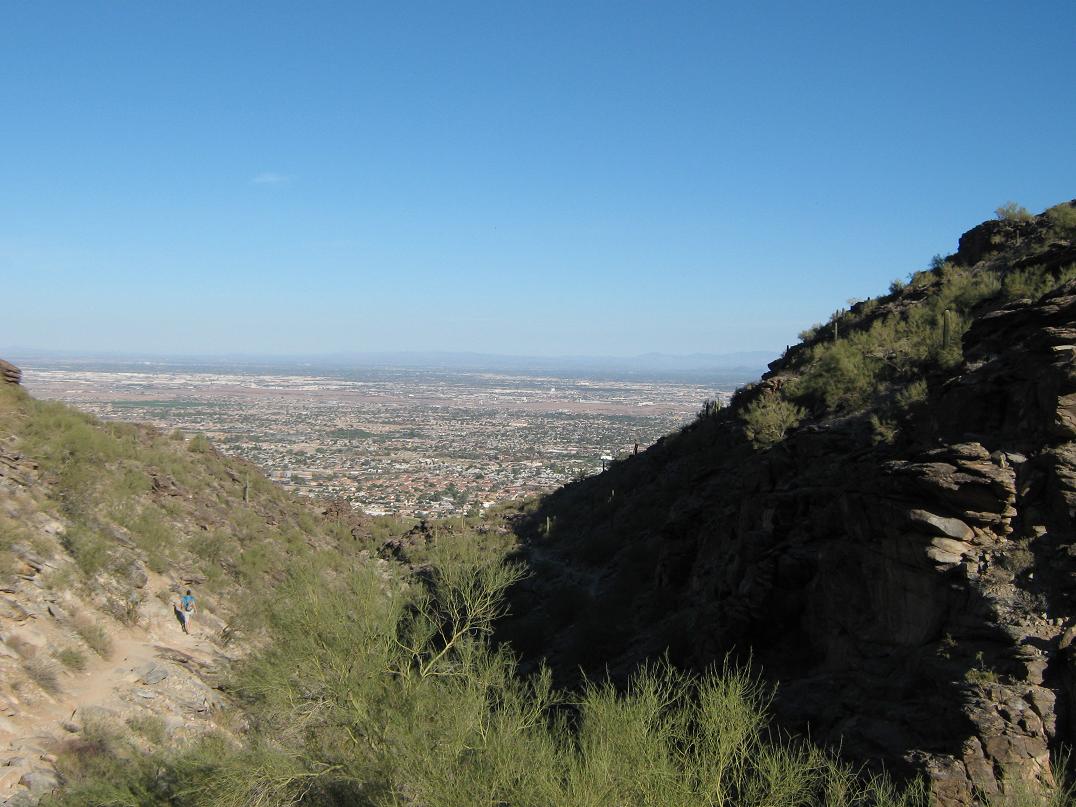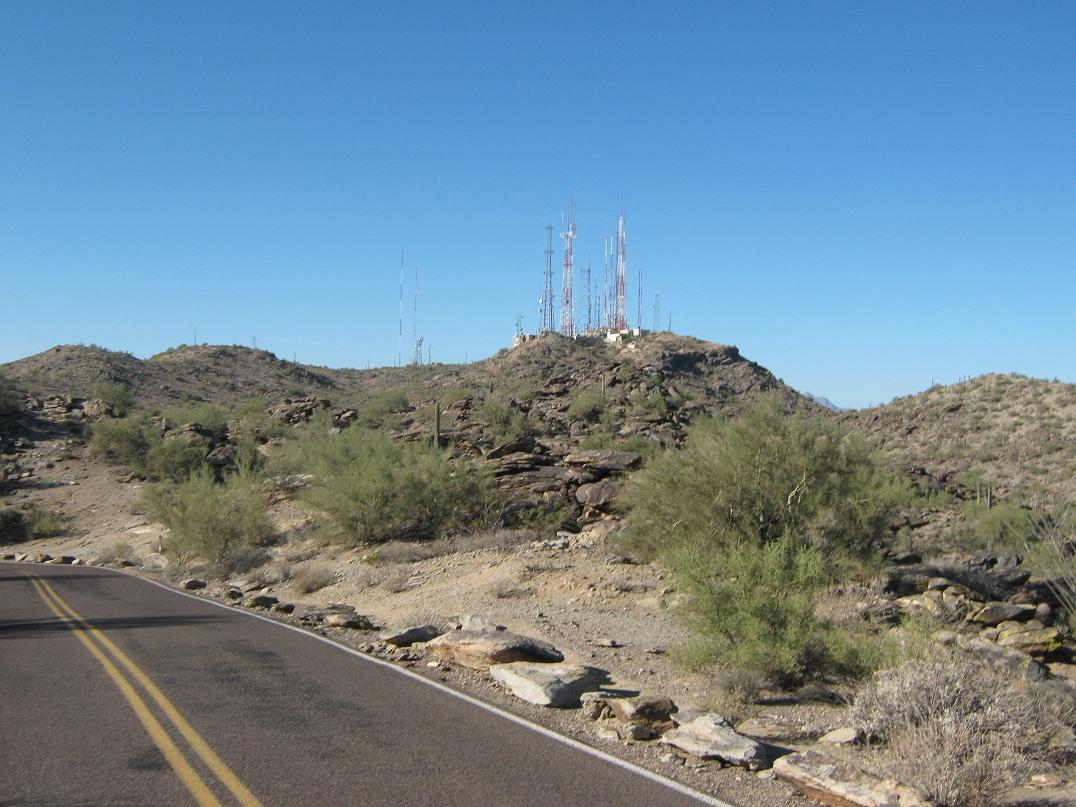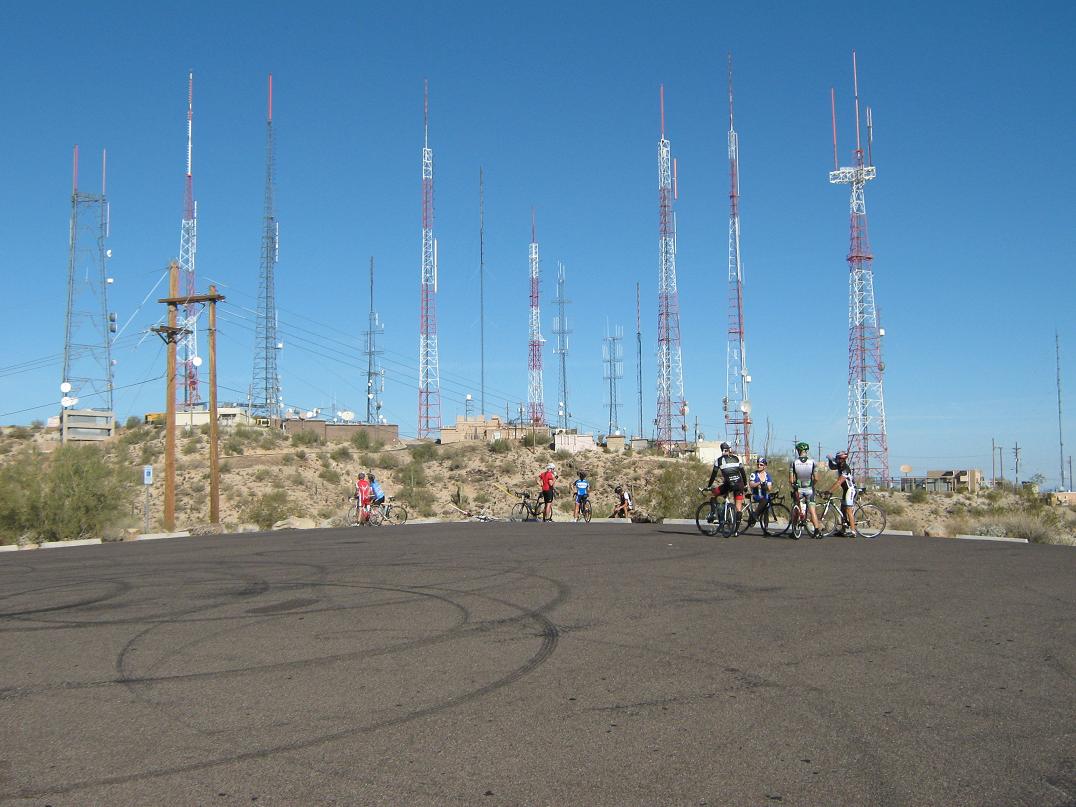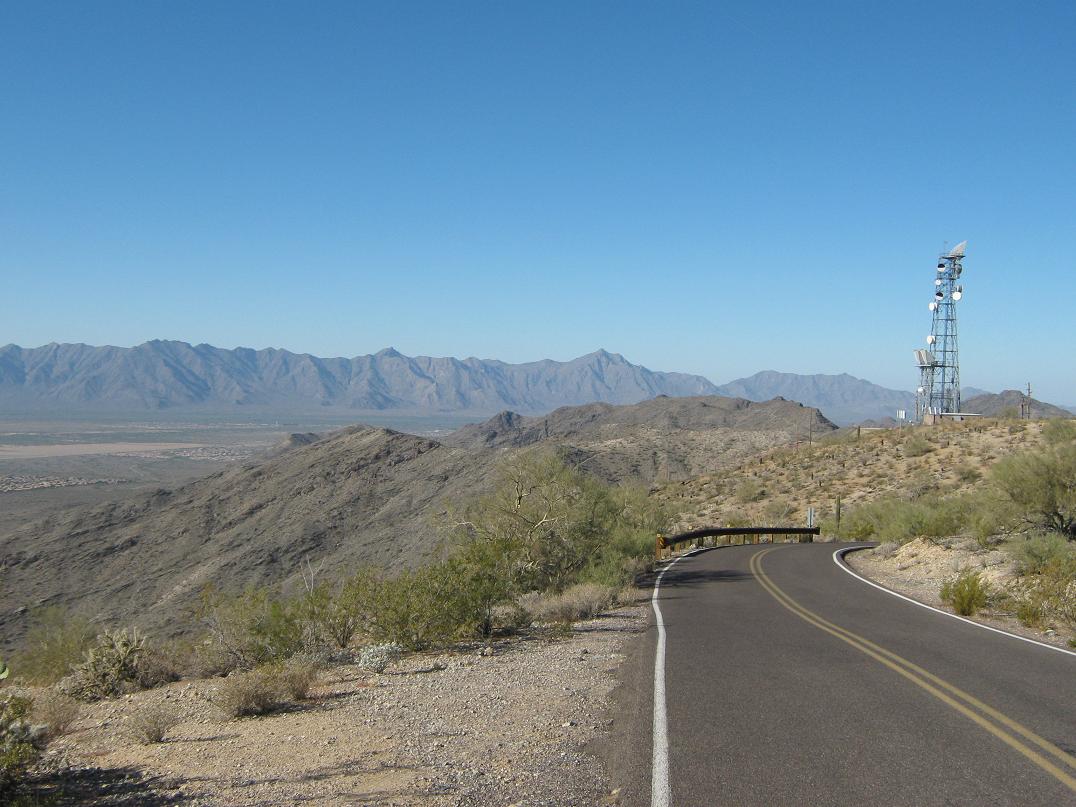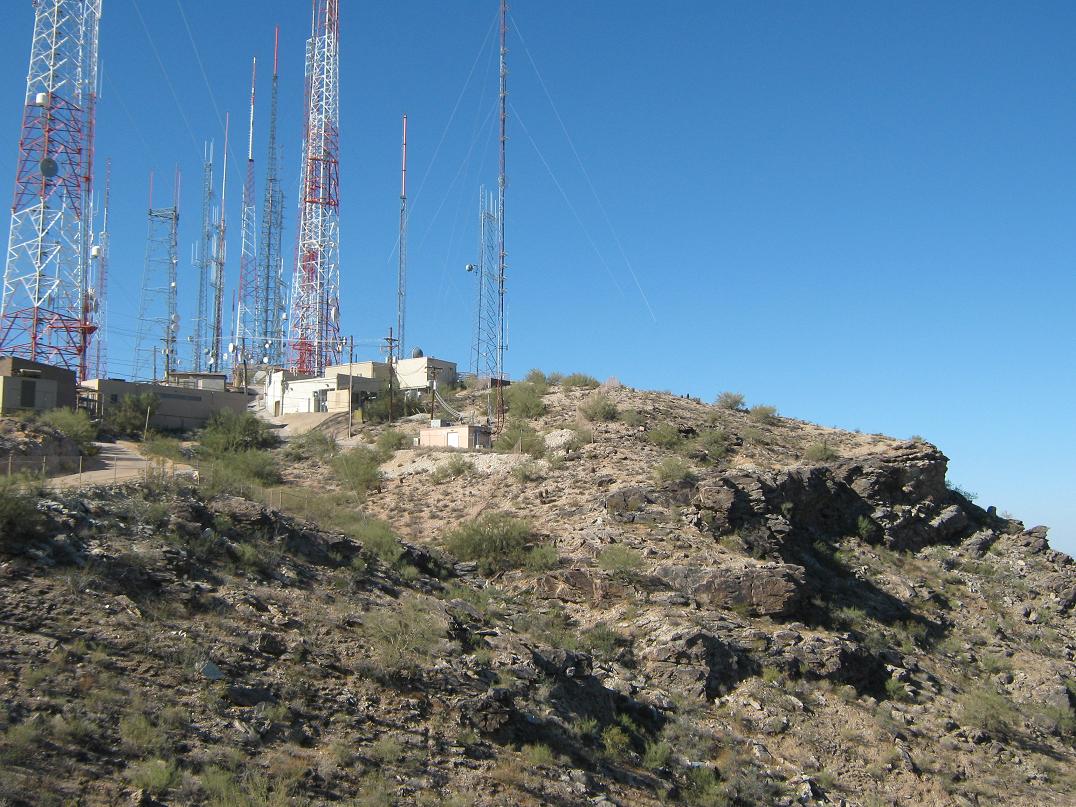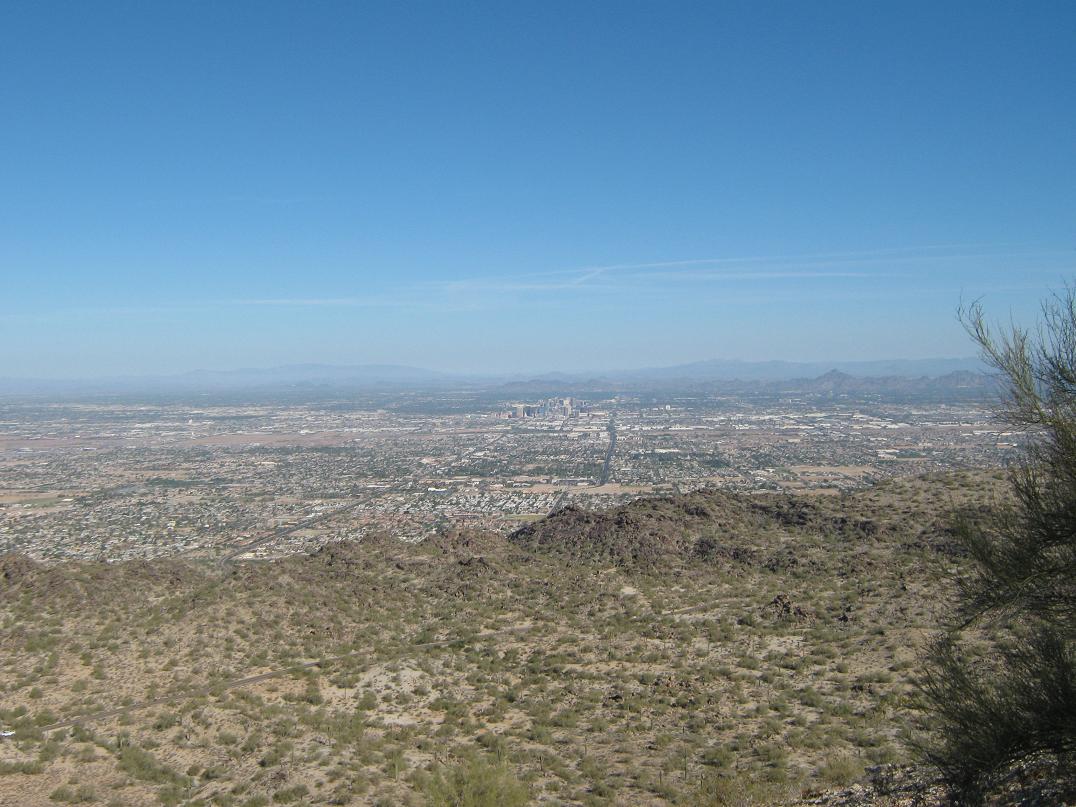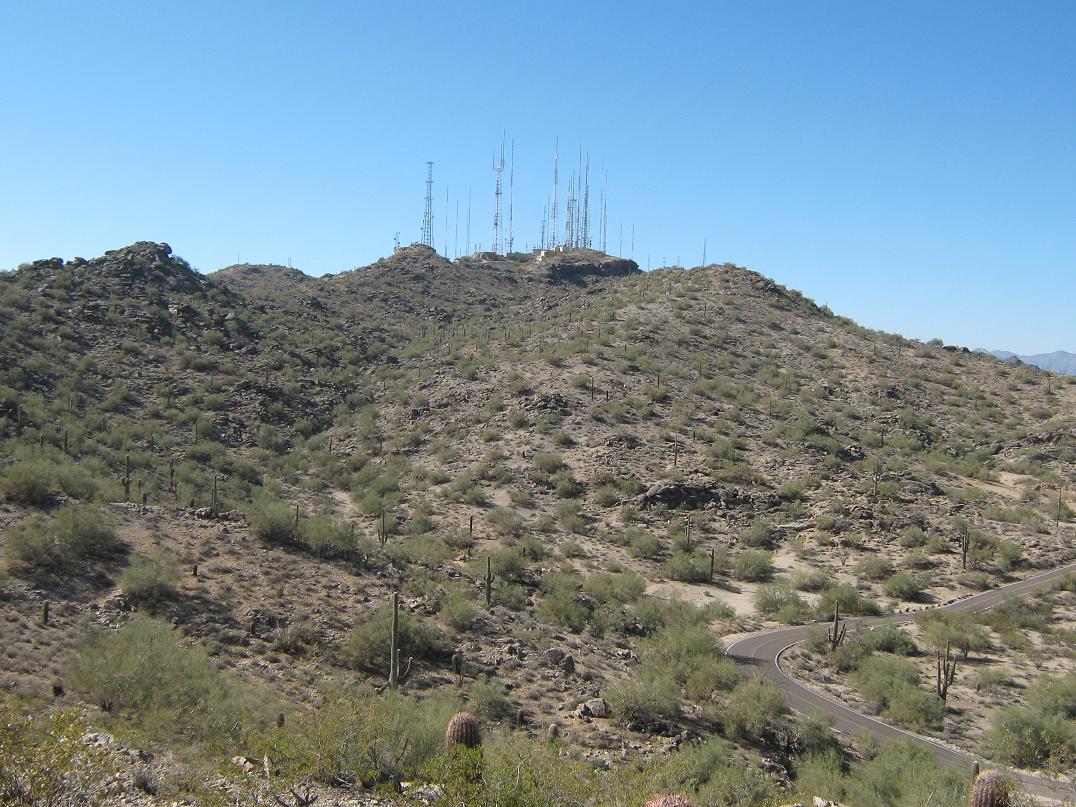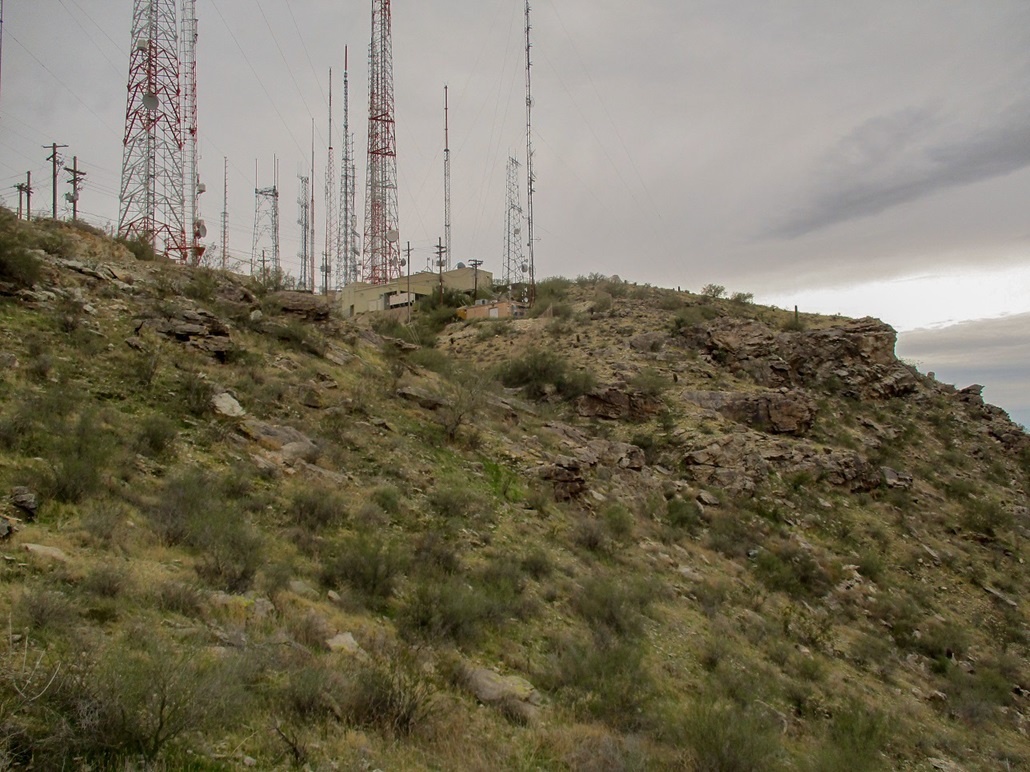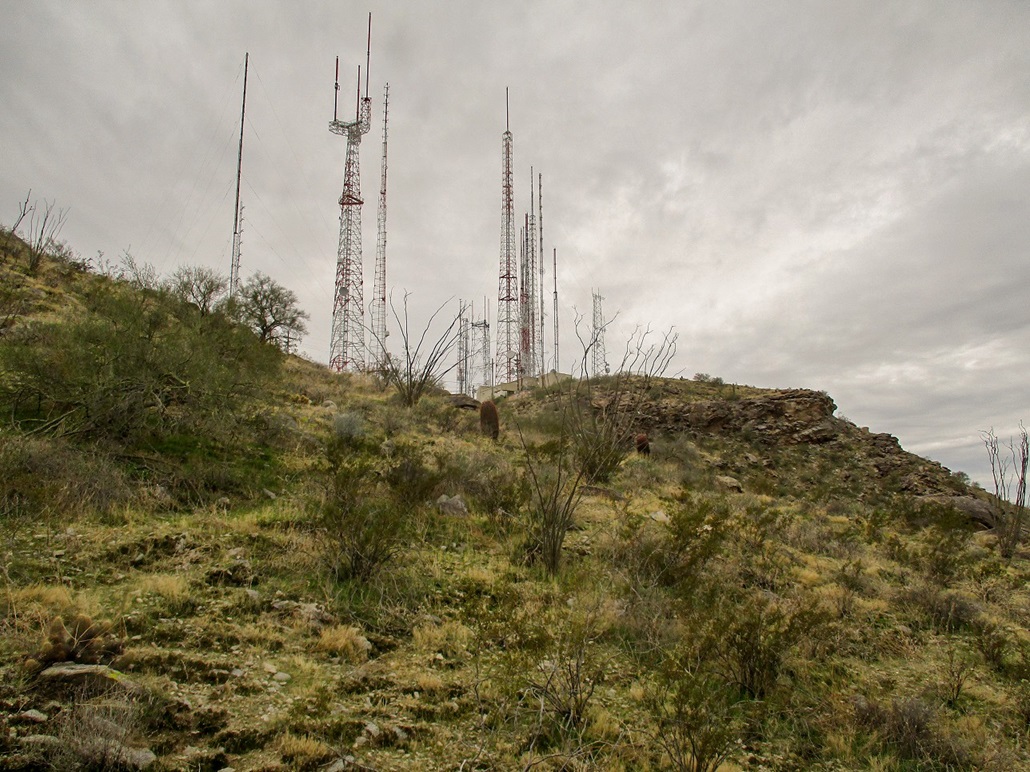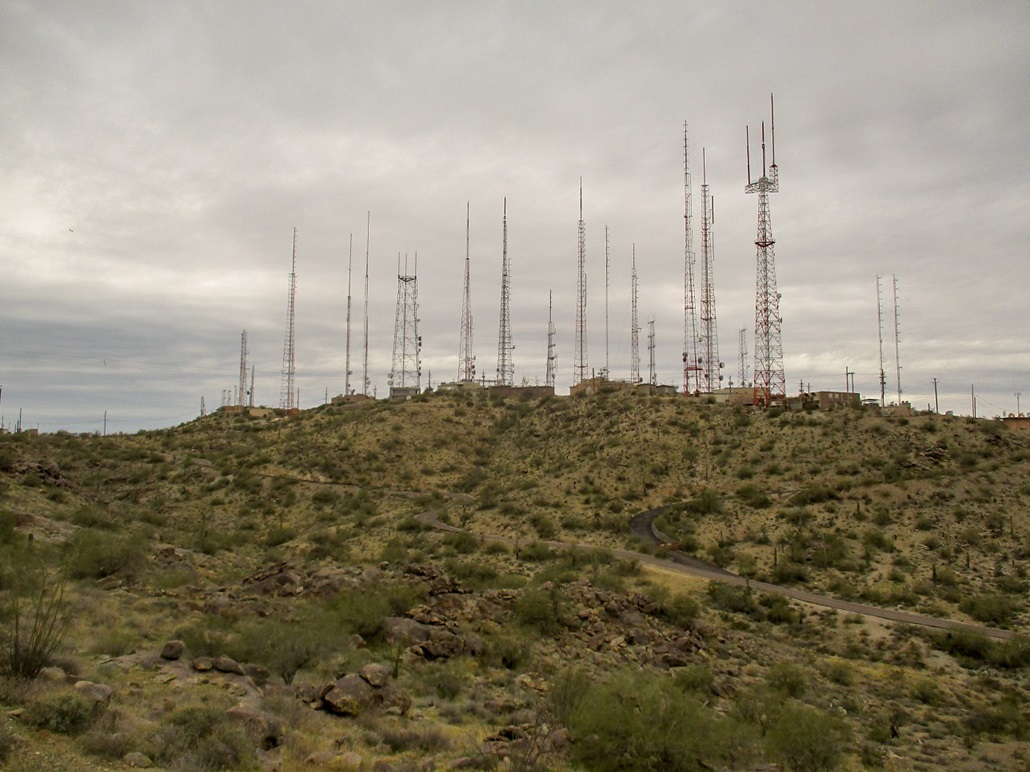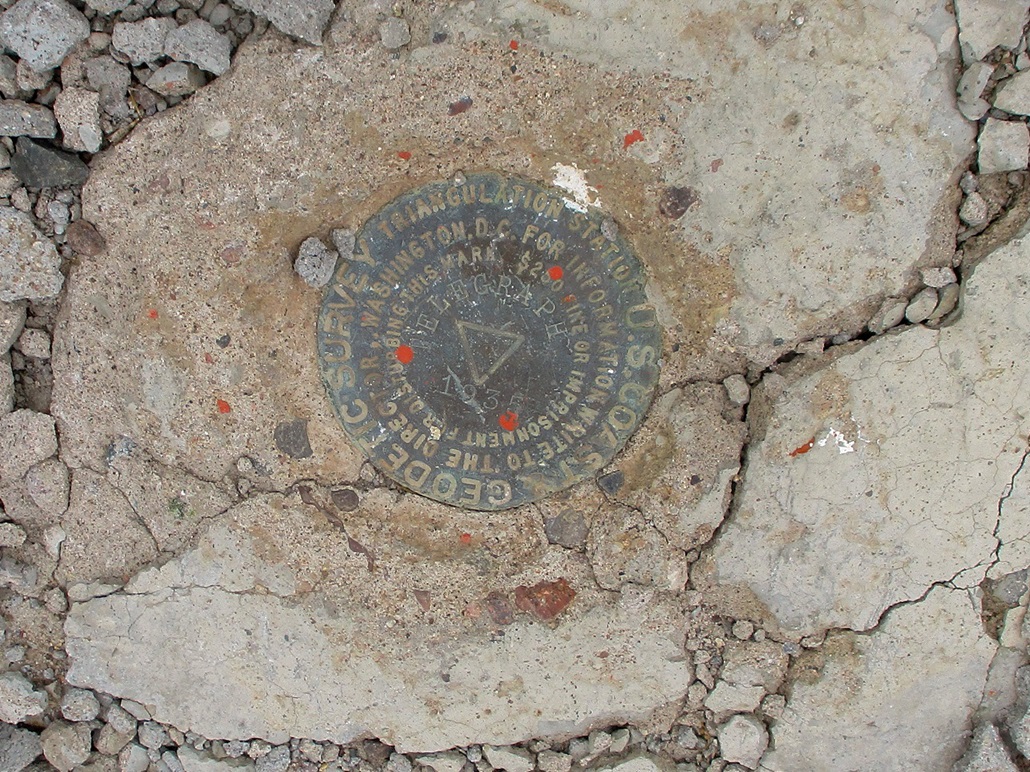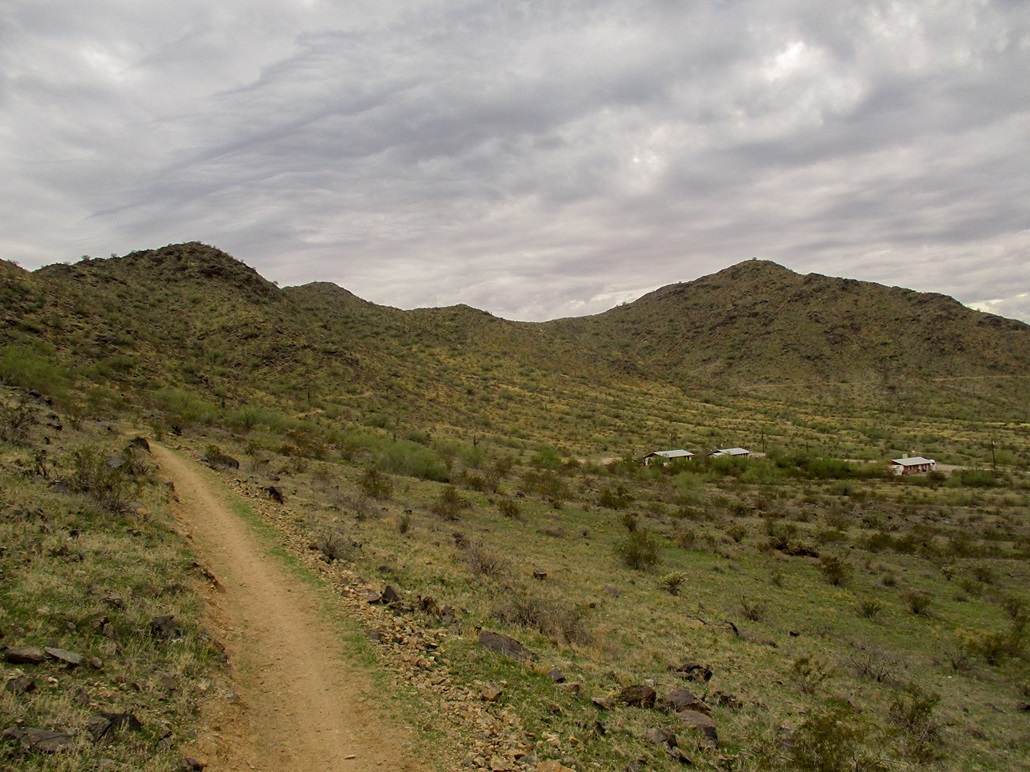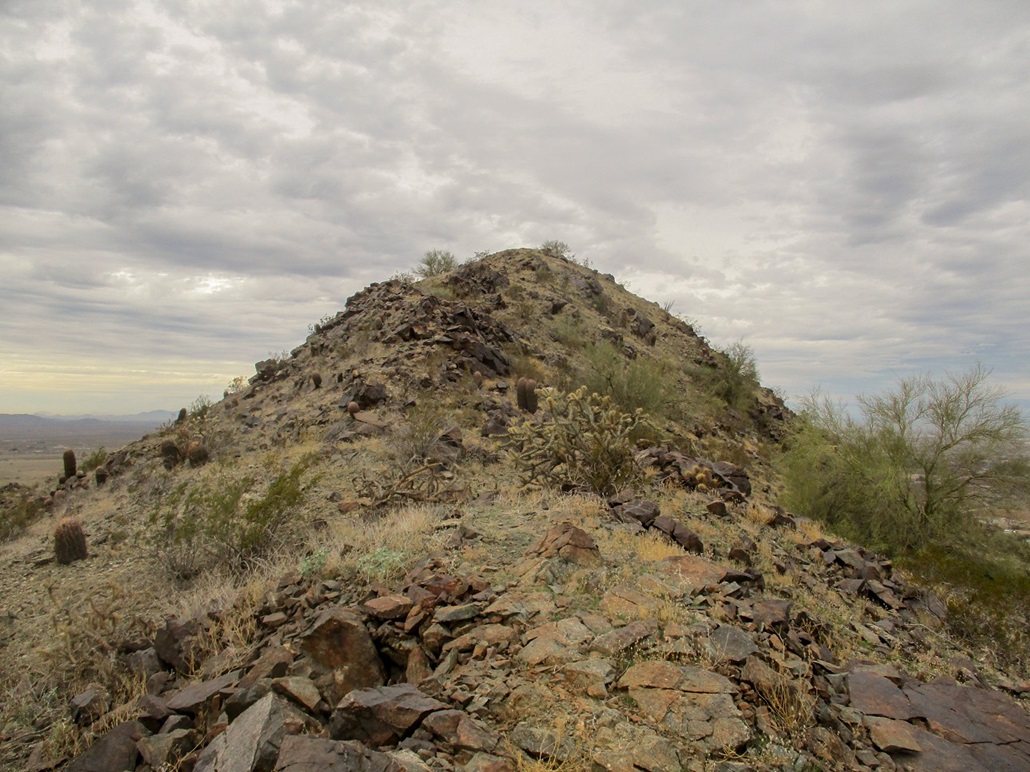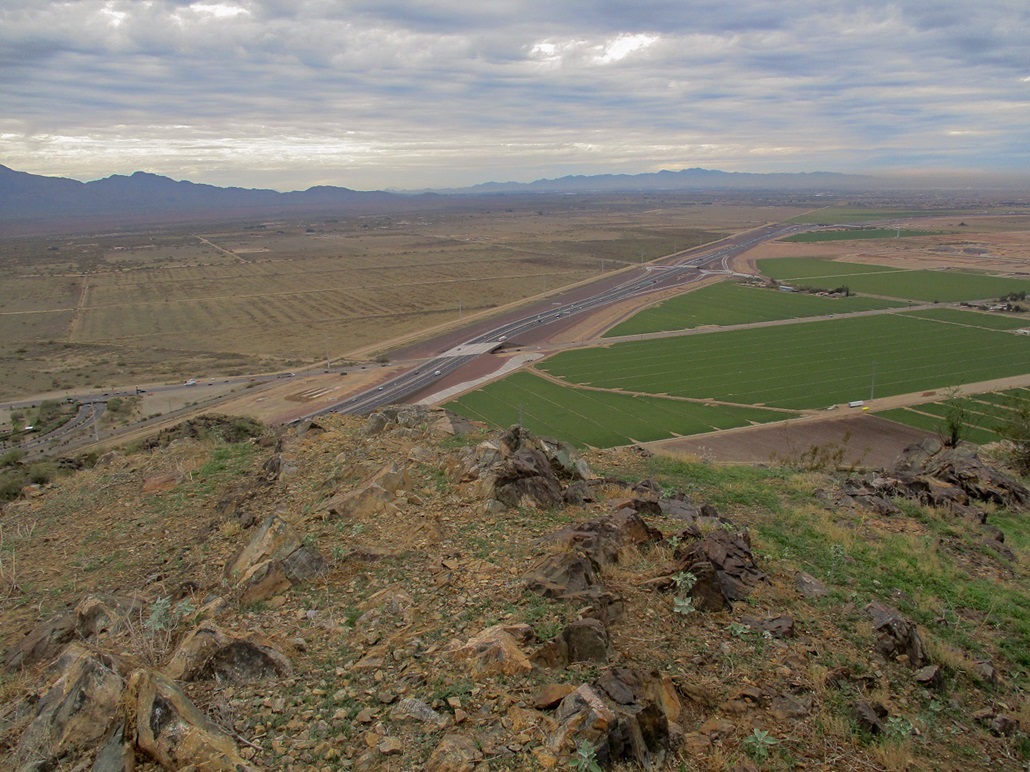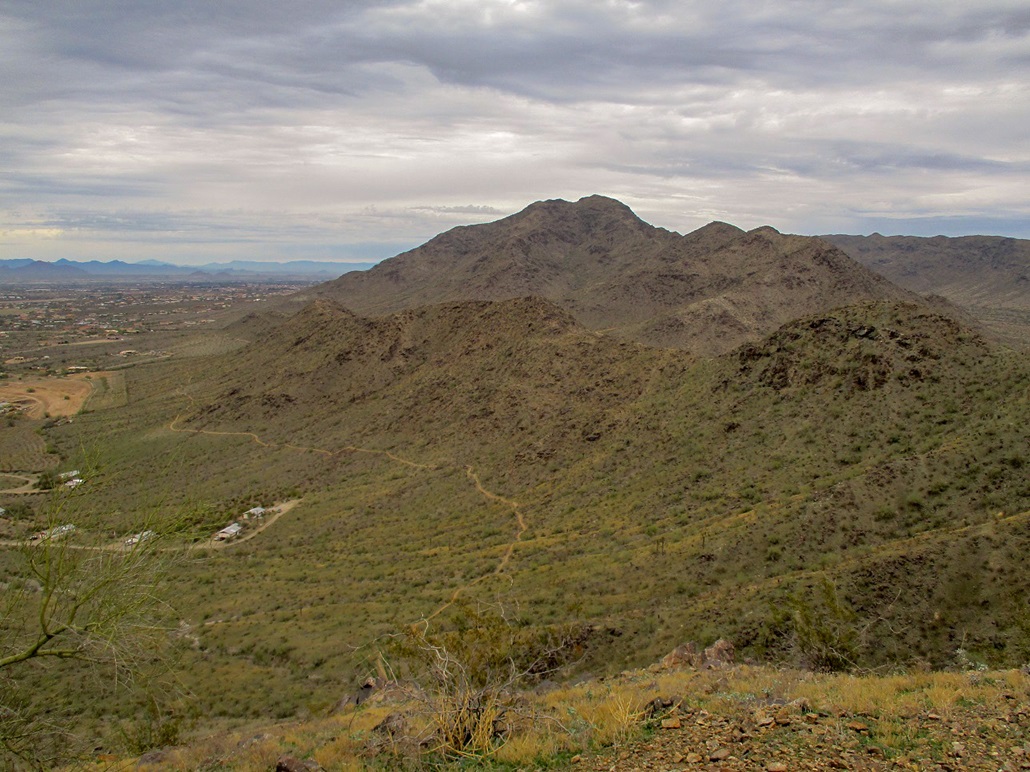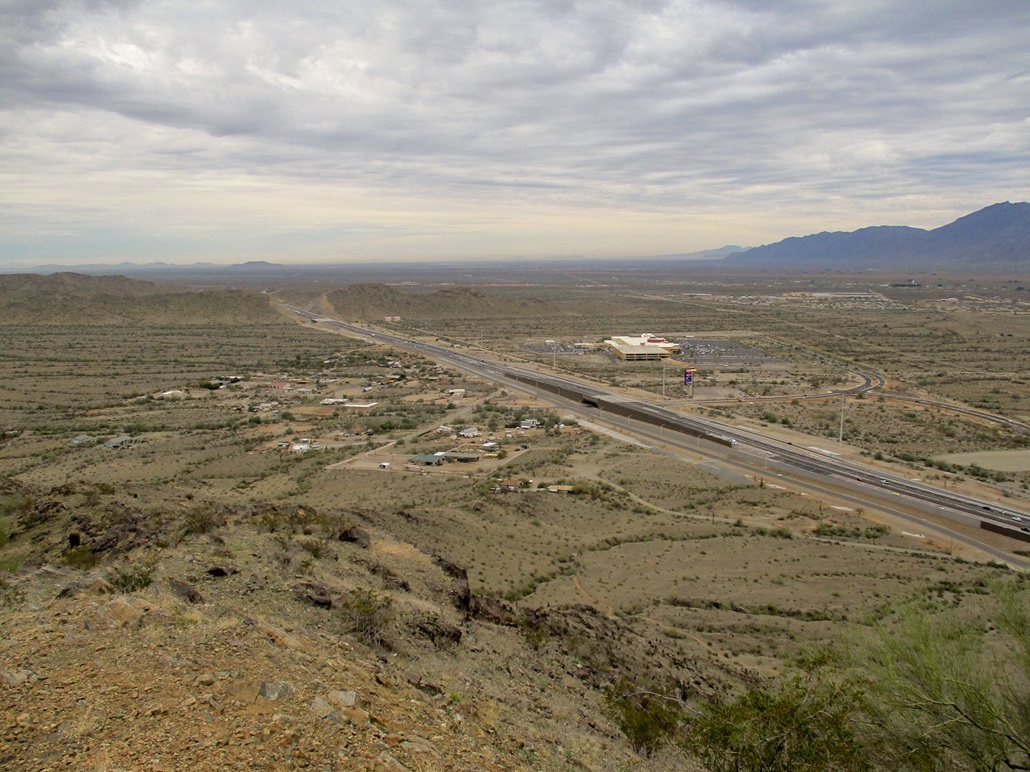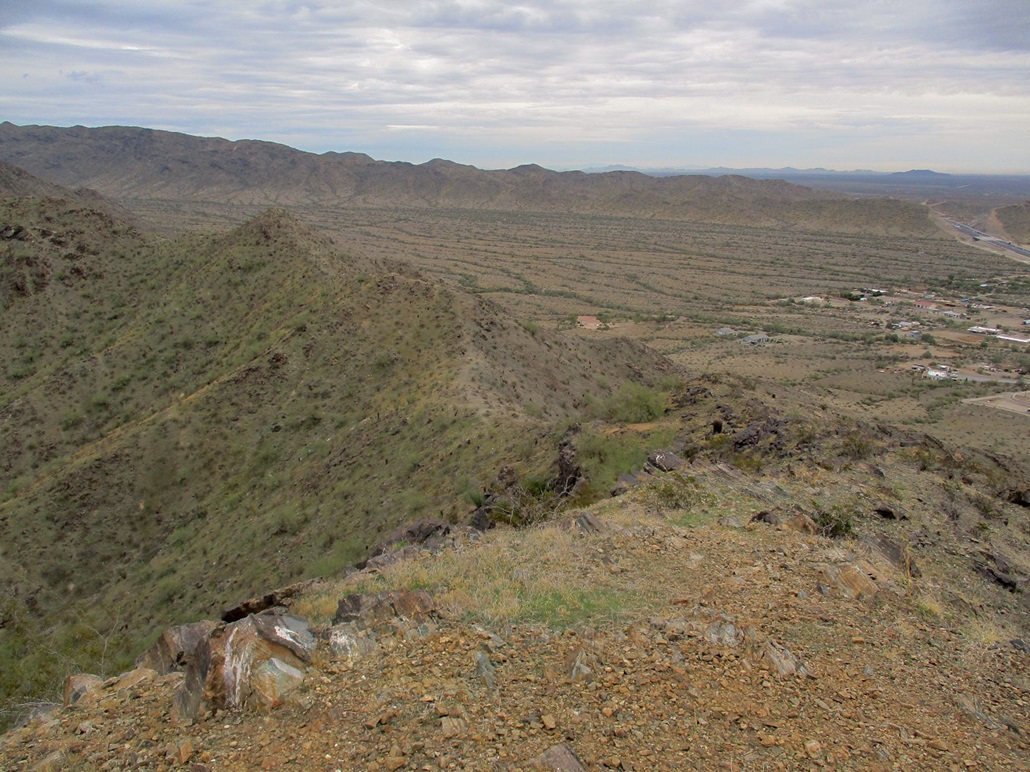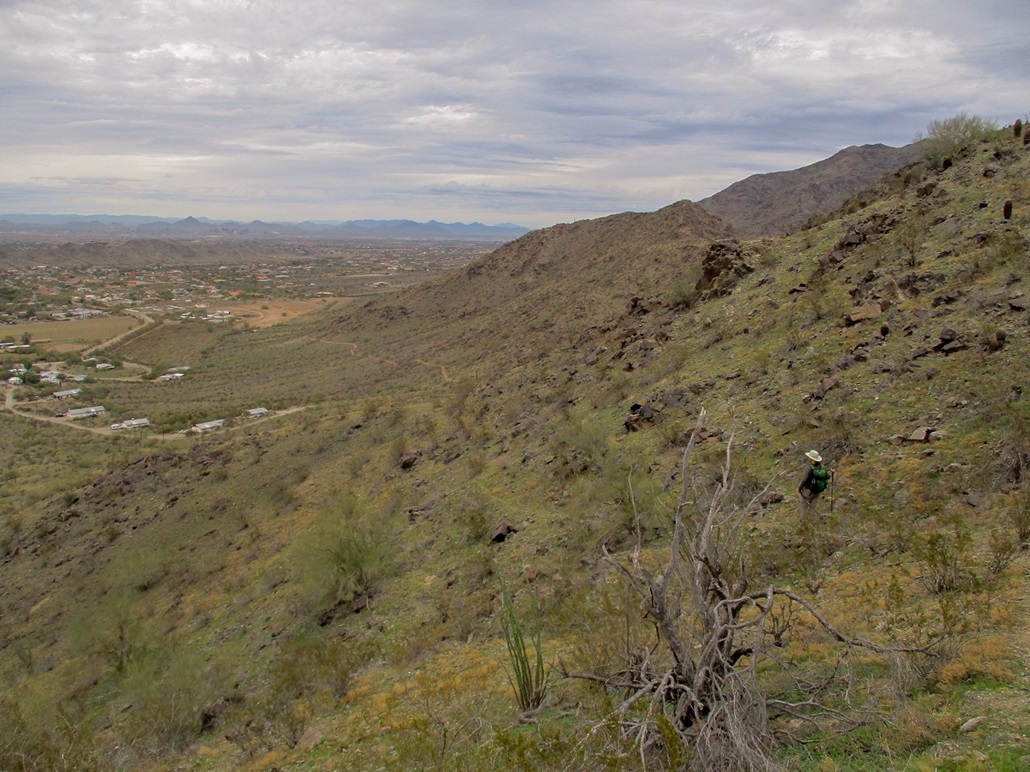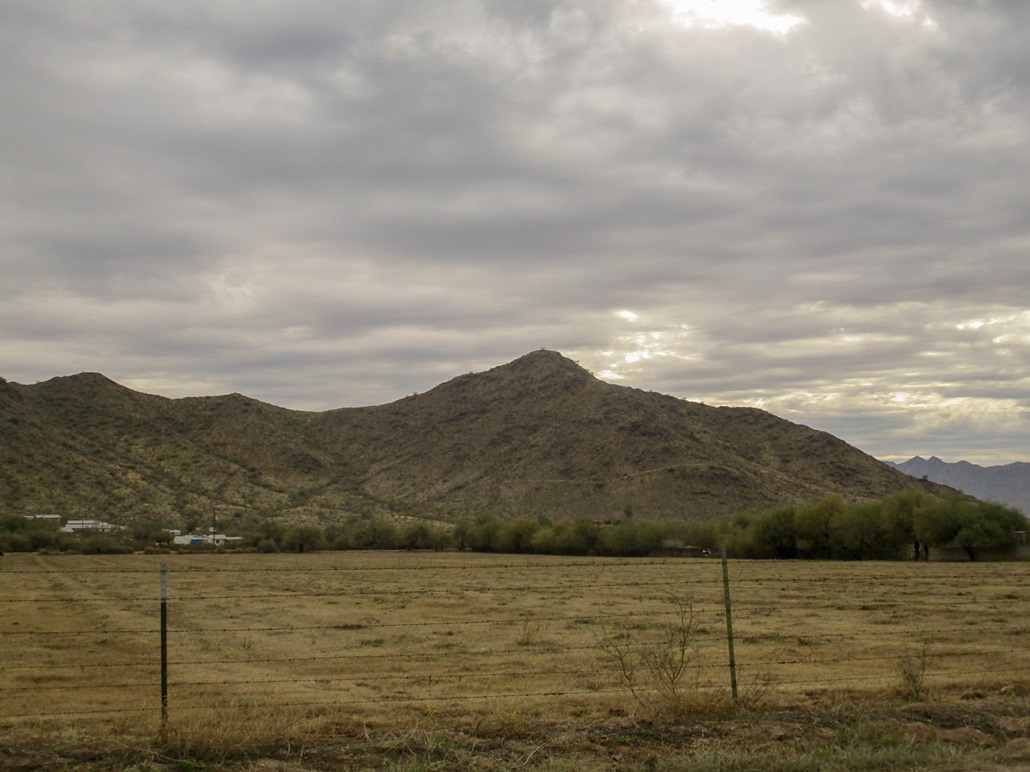
The Mountains of Arizona
www.surgent.net |
|
Gila Lookout • Suappoa Peak • San Juan Hill The South Mountains are a big and sprawling range south of downtown Phoenix, much of it enclosed within the South Mountains Regional Park. The Phoenix city limits encompass the entirety of the mountain range, making it the biggest city park in the country. The range is actually four or five long and narrow parallel ridges on a west-southwest to east-northeast alignment. The main ridge is home to a small city of communications towers. At night, the towers look like they're floating in the sky. The park has dozens of miles of excellent hiking trails, with multiple let-in points. There are also biking trails, horse routes, picnic ramadas and even a go-kart track. I have been to the park many, many times over the years. When I first moved to the Phoenix area in 1992, I came down to hike in the park a few times when I wanted a meandering trail with no set summit or endpoint to worry about. The highest point of the range is within the fenced compound that hosts the communications towers. Because the ridges are so long and uniform, the highpoints don't visually stand out --- there's no obvious pointed summit to aim for. The name of the highest point is also open for debate. Most people just call the whole range "South Mountain". The other common name is Suappoa Peak. Within the towers, the highpoint is marked by a USGS Benchmark stamped "Telegraph".
Date: October 28, 2012
• Elevation: 2,630-2,680 feet
• Prominence: 35 feet (Gila Lookout)
• Distance: 9 miles
• Time: 3 hours, 30 minutes
• Gain: 1,350 feet
• Conditions: Blue skies and pleasant
Arizona
•
Main
•
PB
I originally planned to explore a peak west of here in the Sierra Estrella Regional Park in Goodyear. However, I discovered that the recent development of the area meant that the roads I wanted to follow were built upon, and access had become restricted. I figured I needed to do some more research on that peak, so I bailed, and salvaged the day at South Mountain. I wanted to explore "the summit" of the South Mountains and see how difficult getting to the very top would be.
When I rolled into the main entrance (Central Avenue, heading south), the main paved road was closed, this being "Silent Sunday", which is every 4th Sunday of each month. They close the roads but allow hikers and bicyclists. It makes for less crowds and vehicles, which is nice. I was not expecting this (because I had not done my homework), but I was not put off by this development. I was looking for a good hike anyway. I parked in the large parking area, as far east as I could before the road ended. The lots were filling up fast. I got myself situated, my pack in order, and walked around a little bit, reading some information off the kiosks they have placed around. I quickly determined the Holbert Trail would be my trail for the day.
I found the Holbert Trailhead near the east end of the parking area. It enters into a tight little canyon quickly, then opens up again immediately thereafter. A group of about a dozen people, adults and kids, all seemingly friends, had started just ahead of me, but when I passed them, one kid, about age 8, thought I was a group member and kept on bounding past me. I didn't mind much, but when the rocks got a little steep, I suggested it be best if he waited for his mother. I didn't want him to get hurt trying to keep up with me.
The trail comes to a large water tank, then resumes again, bending south and making long, sweeping switchbacks up the steep rocky slopes. The grades are so gentle that I made excellent time, never really stopping. After another mile or so, it swings hard left (south again) and enters a hanging valley (see the first photo at left). This is about 2 miles from the trailhead, and a side-trail wiggles up the steep slopes to Dobbins Lookout, which is an old stone ramada. This is a popular destination for hikers. I continued past, however, and saw almost no one afterwards.
The trail continues another 0.3 mile (I guess) then comes to the paved "Summit Road", or "TV Tower Road". I crossed the road and caught the trail, as it stayed on a ridge another 0.3 mile before coming again to the same road, now higher, of course. Here, the Holbert Trail ends, and the summit, with all its towers, about a mile west of my position. I decided to walk the remainder up the paved road.
My only company along the road were mountain bikers, huffing and puffing as they ascended, then flying quickly downhill, smiles on their faces. As a hiker, I made sure to stay well right and keep out of their way. The road gains up the south flank of the main summit ridge, then bends left and ends at a big paved lot, sitting directly on top of a small side summit. The lot is called the Gila Lookout, and it would be my "summit" for the day. A bunch of bikers were up here, relaxing before their downhill journey. Gila Lookout is about 2,630 feet elevation, or about 70 feet lower than the true summit, which is locked up behind all the fencing directly across the way.
The fencing is substantial and well-signed. I had no intention to hop any fences or gates, and it would not have been a "quickie" to find the summit. The towers are gigantic and plentiful. The fencing is to keep the riff-raff out. But I suspect it's more to keep the petty vandals out, those who would spray paint everything, or drink beer and litter the place. The towers are way too big to be damaged by mere humans. From below in town, they look so flimsy, but up close, they're as beefy as any big building in the city.
I was still curious enough to wander around the perimeter fencing. Below the towers on the main road, I cut across a slope to the National Trail, which cuts high across the north flanks of the summit. I later found an older trail that leaves the National Trail and angles directly upward. This was obviously the old summit trail. So I followed it, and some combination of cross-country, to get myself to the fencing. I then walked west along the fencing, following narrow trails and paths. I was aiming for the highest land I could see outside the fencing. This would presumably put me close to the actual summit.
I was able to get to my desired point, but there was no easy place to scoot under, and climbing over the fencing was out of the question. Also, I was not certain if I was near the actual highest point, or if a more pointed summit off to the west was the actual highpoint. I didn't want to waste my time inside the fencing only to find the true top was somewhere else. So I decided to not bother, and kept myself on the legal side of the fence the entire time.
Later, I learned the summit is near where I had been standing, so yes, all one would need to do to claim the top would be a quick fence-breach, run to the top, tag the benchmark, then a fast exit. Since I didn't do this, I can't yet lay claim to a successful ascent of Mount Suappoa. I did get as high as about 2,680 feet (the summit being about 2,700-2,710 feet). Some day I'll get up there to tag it, but it's not a priority, so it may be awhile. Check back regularly.
The down hike went well, and I was back to my truck after three and a half hours on the trail. I was surprised to discover I had climbed over 1,300 feet in elevation, since it felt like half that. Given all the extra exploration I did, my total mileage came closer to nine miles. The day was warm but lovely, and I had a great hike overall.
Date: December 23, 2019 • Elevation: 2,710 feet • Prominence: 1,510 feet • Distance: 1 mile • Time: 1 hour • Gain: 65 feet (net), 535 feet (gross) • Conditions: Cloudy and cool • Teammate: Matthias Stender
AZ P1K
•
PB
•
USGS BM Datasheet
Matthias and I tagged the magical benchmark on top of the peak, thus "officially" summitting Mount Suappoa. It was a spur of the moment thing. We texted a little in the morning and decided to try for the top. The day was gloomy with low clouds and a little chilly.
We drove to the Gila Lookout parking lot, and hiked down the road then a portion of the National Trail. We then hiked on older paths. We knew exactly where to go, so when we were at the correct place, we made a very quick dash up the rubble slopes to the benchmark, took a photo, then scooted right back down and back onto the older trails. The hike took an hour, and it felt good to "bag" this peak.
The hike itself was a 230-foot drop down the road, then regaining it all plus a little extra "around back", roughly a half-mile of total walking. Coming back, we had to drop the regain similar elevation, so we ended up putting in about 535 feet of gross elevation gain.
The benchmark is stamped "Telegraph". The whole summit area is called Mount Suappoa, or Mount Suppoa. Most people just call it all the South Mountains. The online mappers place the little tag for Mount Suappoa at the west end of the high ridge, where there is a small stand-alone peak, but this bump is about 25 feet lower than the benchmark.
We then drove a few miles and hiked another ranked peak in the range, San Juan Hill.
Elevation: 1,677 feet
• Prominence: 317 feet
• Distance: 3 miles
• Time: 90 minutes
• Gain: 570 feet
• Conditions: Cloudy and gray
• Teammates: Matthias Stender
PB
•
LoJ
San Juan Hill is at the west end of the South Mountains in south Phoenix. It used to be possible to drive to the San Juan parking lot from within the South Mountains Park. The parking lot sits in a saddle connecting San Juan Hill to the main mountain mass of the South Mountains. These days, it is open just one weekend a month. However, hiking it is not barred in any manner.
Back in the 1990s, I used to drive up to the San Juan parking lot when I was bored and looking for something to do. I would hike the paths, either going east (the Alta Trail, which leads to the Ma Ha Tauk Ridge Highpoint), or west, onto this hill. I didn't tag any summits back then. I would usually just stroll until I felt I'd had enough, then hike back to my car. I've always known the hill as San Juan Hill but am surprised it is not labelled as such on any maps. I must have heard it from someone back in the day and assumed that's what it is called. It would be a natural name to call it.
Earlier today, Matthias and I teamed up to tag the benchmark atop Suappoa Peak. But we wanted something else to hike while here, so I suggested this hill. For both of us, it would be the final of four ranked summits within the South Mountains we would climb.
From the main entrance into the South Mountains park, we drove west along Dobbins Road to 51st Avenue, then south to Estrella Drive, then east a mile past 43rd Avenue, then another few hundred yards to park along a dirt road near an ingress point into the park, this one obviously not developed for the masses. There was just one other car here when we rolled up. The day was cool with heavy cloud cover, the front of a storm that would move in tomorrow.
We hiked up a path to gain another path, this one circumnavigating San Juan Hill and apparently a bicyclist's path judging by its appearance (mostly level, good tread). This path does not appear on the official park maps (as of December 2019). For us, it would be welcome since it would get us close to the base of the hill quickly.
We hiked about a mile south and west along this path, gaining not very much over that distance, perhaps 75 feet. We were below the top on its northeast, and tucked up against the low ridge that leads to it. Thus, it made sense to leave the trail here and start up a side-ridge to gain the main crest.
We started up this side ridge, the terrain open and easy to manage with little brush. There were a lot of paths in every direction, but as we gained about a hundred feet, one path kept to the spine of this ridge and is probably a lightly-beaten hiker's path. This led to a junction with the path atop the main range crest. We'd gained about 300 feet from where we left the good path.
The summit was right there to the west, another 120 feet above us. The path would get weak in the ridge rocks, but we were able to keep to what looked obvious and soon, were on top the peak. A single palo verde grows up here. Otherwise, it was rocky but with places to sit and relax. The one-way hike had taken about 40 minutes with about 550 feet of total gain in a mile and a half.
The interesting views were down onto the brand-new freeway, the Loop-202 through Laveen and the Gila River Indian Reservation. This freeway has been under construction for years and just opened, about ten days ago. It was still shiny and looked like it came right out of the box. We looked around at the other peaks, but it was chily up here and the gray skies muted any interesting light we might have for photos.
We hiked down the same route, and were back to the cars in another 45 minutes. The hike went well and was easy, with nothing to slow us down. At this point, we shook hands and went our ways. I followed the new 202 back home, my first time on this new segment of freeway.
|
|
